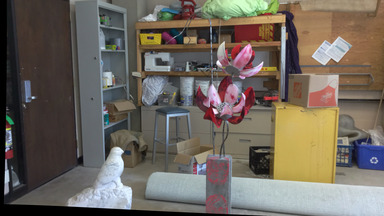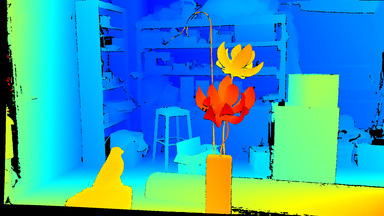















































SCENE{1,2,3}/ -- scene imaged from 1-3 viewing directions
ambient/ -- directory of all input views under ambient lighting
{F,L,T}{0,1,...}/ -- different lighting conditions (F=flash, L=lighting, T=torch)
im0e{0,1,2,...}.png -- left view under different exposures
im1e{0,1,2,...}.png -- right view under different exposures
calib.txt -- calibration information
im{0,1}.png -- default left and right view (typically ambient/L0/im{0,1}e2.png)
disp{0,1}.pfm -- left and right GT disparities
Zip files containing the above files can be downloaded
here. "all.zip" contains all 24 scenes (image pair, disparities,
calibration file), but not the ambient subdirectories. The latter
are available in separate zip files.
cam0=[1758.23 0 953.34; 0 1758.23 552.29; 0 0 1] cam1=[1758.23 0 953.34; 0 1758.23 552.29; 0 0 1] doffs=0 baseline=111.53 width=1920 height=1080 ndisp=290 isint=0 vmin=75 vmax=262
Explanation:
cam0,1: camera matrices for the rectified views, in the form [f 0 cx; 0 f cy; 0 0 1], where
f: focal length in pixels
cx, cy: principal point
doffs: x-difference of principal points, doffs = cx1 - cx0 (here always == 0)
baseline: camera baseline in mm
width, height: image size
ndisp: a conservative bound on the number of disparity levels;
the stereo algorithm MAY utilize this bound and search from d = 0 .. ndisp-1
vmin, vmax: a tight bound on minimum and maximum disparities, used for color visualization;
the stereo algorithm MAY NOT utilize this information
To convert from the floating-point disparity value d [pixels] in the
.pfm file to depth Z [mm] the following equation can be used:
Z = baseline * f / (d + doffs)Note that the image viewer "sv" and mesh viewer "plyv" provided by our software cvkit can read the calib.txt files and provide this conversion automatically when viewing .pfm disparity maps as 3D meshes.
Support for this work was provided by NSF grant IIS-1718376. Any opinions, findings, and conclusions or recommendations expressed in this material are those of the authors and do not necessarily reflect the views of the National Science Foundation.